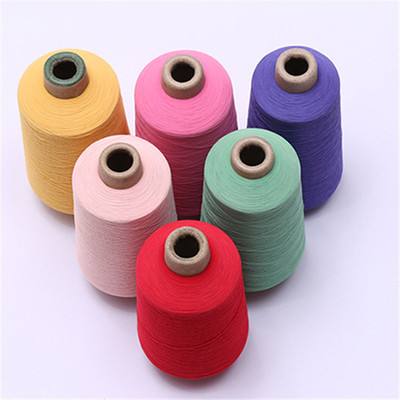How to ensure the quality and production efficiency of nylon yarn?
Nylon is a synthetic fiber that can be made into long or short fibers. Nylon is a term for polyamide fiber (nylon), and its appearance has given textiles a completely new look. Its synthesis is a major breakthrough in the synthetic fiber industry. In today's society, with the development of science, synthetic fiber technology has also made significant progress. Synthetic fibers are widely used in industrial production such as textiles and clothing due to their good shaping effect, high strength, good elasticity, and strong wear and corrosion resistance.
nylon colored yarnCharacteristics:
1. Due to its strong strength and wear resistance, it is commonly used as socks, gloves, and knitted sportswear.
2. Good elasticity, high strength, and high wear resistance, which are outstanding in current fiber applications.
3. Good moisture absorption, wear-resistant but not acid resistant, so nylon products are not easy to store with sanitary balls.
4. Poor light resistance, prone to yellowing and reduced strength when exposed to sunlight, therefore cotton products should not be dried after washing.

In the production process of synthetic fibers, the melt is sprayed out from the spinning holes on the spinning plate to form primary fibers, which are then processed into finished synthetic fibers through subsequent processes. The existing spinneret used for producing nylon fibers has circular nozzle holes. The fibers produced by circular holes have a solid structure inside, arranged tightly, and lack hydrophilic structures between molecules, resulting in low moisture regain, poor moisture absorption and dyeability, and a smooth surface. When light shines on the surface, diffuse reflection is easily formed, resulting in poor luster and difficulty in meeting people's needs, especially for producing interior fabrics for automobiles and airplanes.
In addition, in the existing production of nylon yarn, in order to give the primary fibers a specific color, color masterbatch is usually added to the slicing melt extrusion screw. The existing injection and installation of color masterbatch mainly include the slicing melt extrusion screw and the color masterbatch addition and installation located in front of the slicing melt extrusion screw. However, the existing color masterbatch addition and installation can only work in the power frequency state and do not have the function of variable speed addition. It cannot be adjusted with production requirements or changes in production status, making it difficult to control the addition of color masterbatch. The color uniformity of nylon yarn fibers is poor, and the production speed and quality of nylon yarn are low.
In order to address the shortcomings of the above technology, a production and installation of nylon color yarn with improved nylon fiber quality and good color uniformity is adopted. It mainly includes a slicing melting extrusion screw, a spinning plate with spinning holes, a side blowing air conditioner, an oil cooling installation, and a winding installation arranged in sequence from top to bottom. Its feature is that a colored masterbatch variable frequency injector is installed in front of the slicing melting extrusion screw; The nozzle hole is in a straight shape. It can achieve excellent results for nylon yarn. When in use, the motor speed can be adjusted through frequency conversion installation to effectively control the extrusion speed of screw 7, so that the amount of color masterbatch added can be effectively controlled according to actual production needs. At the same time, with the increase of production speed, the injection speed can be accelerated, thereby ensuring the quality of nylon yarn and improving production efficiency.
Article source: Nylon colored yarn
-
05-27
The reason why fabrics containing spandex are prone to yellowing
Spandex is a commonly used fiber variety in our daily lives, characterized by good elasticity, low fineness, high elastic modulus (cracking elongation can reach 400-800), and low specific gravity. Spa
-
04-24
Colored non dyed nylon with synthetic fiber raw material
The current conventional fiber coloring mostly uses yarn dyeing method, which has long process, high loss, high cost, and the product has color difference and low color wash fastness. Yarn is prone to
-
03-26
What are the characteristics of non dyed spandex?
Non dyed spandex has also been widely used in recent years. Non dyed spandex fiber can be blended with fibers such as nylon, polyester, acrylic, cotton, wool, etc., which can give fabrics excellent el
-
02-24
The influence of yarn structure on fabrics
The basic characteristics of yarn include its appearance and shape, twisting characteristics, fiber transfer and distribution characteristics in the yarn, as well as the surface fuzz and internal loos
